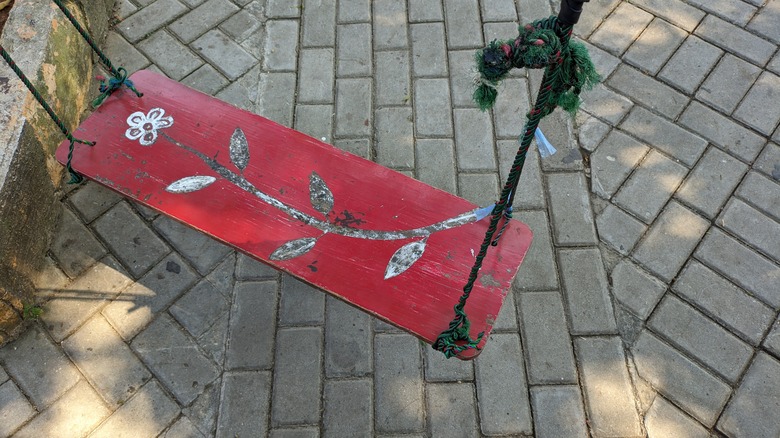Even Beginners Can Pull Off This DIY Porch Swing With A Few Scrap Materials
We think of porch swings as large, elaborate contraptions suitable for sipping hot cocoa or kombucha and relaxing with a throw and a good book. Maybe a murder mystery, or a tome about the cyclical history of international banking. Geez, adults, when did you forget how to have fun? Some of these swings are, quite literally, IKEA beds suspended from the porch ceiling. Which is lovely, but sometimes a swing is meant, first and foremost, for swinging. Canadian TikTokker and artist Kate Morse still apparently holds onto this secret knowledge from childhood, and she has found the simplest possible way for you to reclaim that sense of innocent fun by building a swing for swinging of your very own.
Morse, her mother, and her sister operate The Greenhouse in Nova Scotia, and its arbors are the home to two of these DIY swings. The Greenhouse is a gorgeous rental venue (think intimate weddings and photo shoots) that at once elevates and balances the pure fun of the old-school swings.
Make your own simple swing
Morse explains how she made her swings in an unusual amount of detail for a TikTok how-to video, which should be easy for any DIYer to follow. She started with an old 2x10 board, cut to a length of about three feet. She marked center points for four holes at each corner, 2 ½ inches from each side, then used a 1 ⅜-inch spade bit to drill the holes themselves. She sanded the swing well (a splinter in your bum would be, well, a bummer), added hand-drawn decorations (Morse is an artist), and stained the boards to match the Greenhouse. The porch swings are installed the way most are: they are attached to two large eye screws set in the arbor frames with three strands of rope per hole, braided and affixed to carabiner-style snaps for easy removal.
It turns out to be a reasonably cheap project, too. Assuming you can use scrap or reclaimed wood for the seat, that leaves two screw eyes rated for at least 150 pounds of working load ($1.97 each); some rope (100 feet of this 3/8-inch manilla rope with a 122-pound working load is $9.94, but you can go thinner if you are braiding it like Morse did); and two spring links with a working load of at least 150 pounds (also $9.94). This brings you to a total of $23.82... not a bad price per hour of fun!
Variations on a swing theme
You maximize your fun by customizing this swing for your own family. First of all, there's no reason it has to be on a porch; Morse's aren't, after all. In fact, this swing design looks most at home hanging from a high, horizontal tree limb. And imagine the fun that could be had if it were positioned so that you could use the swing to launch yourself into a lake or pond? (This is where adult thinking should kick in, though. Do all fun things safely.)
It also doesn't have to be a simple board. The idea is to make a simple swing that meets your needs, and if you need to swing with a few of your favorite brothers and sisters you can make a platform swing instead by building a rectangular 2x4 frame, covering it with plywood, and ideally covering that with cloth (remember the bit about bummer splinters). You could also bypass the plywood and cloth and just use cargo netting; just be sure to check with weight limits. And you can add padding to just about any swing to good effect.

